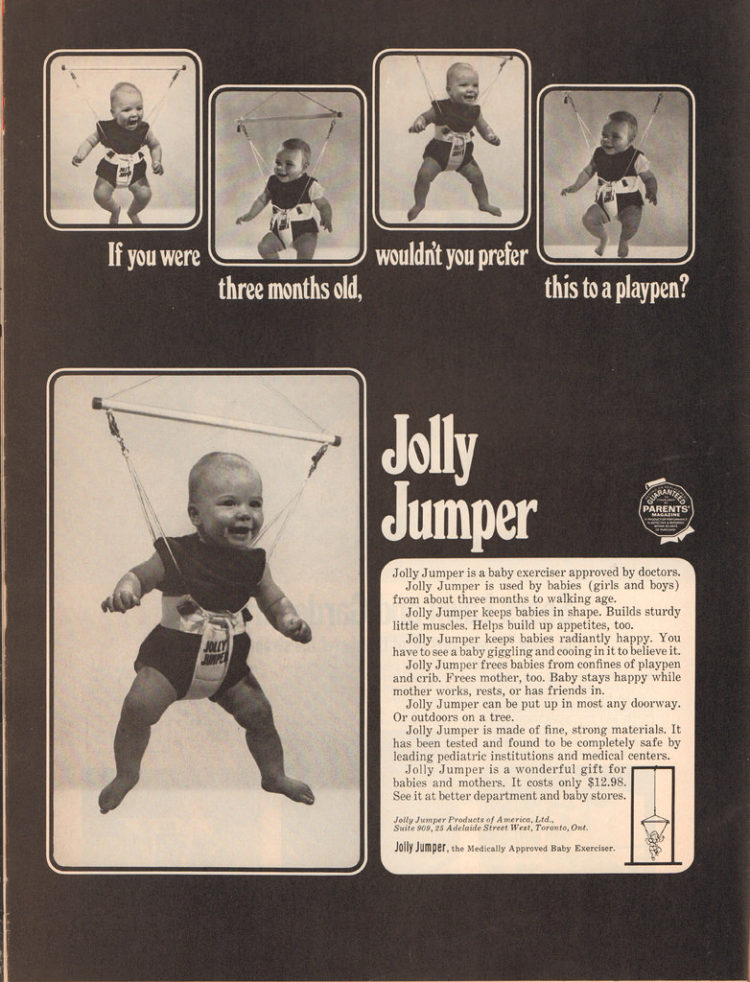It’s been 60 years since Susan Olivia Poole first patented and produced a children’s toy that has stood the test of time – the Jolly Jumper.
Based on a traditional swaddling technique, the Jolly Jumper is now promoted as a ‘baby exerciser’, and is distributed by some of the biggest box stores and brands in the world, from Amazon to Walmart.
This device, I’m sure, has been a godsend for thousands of mums and dads who just need a little ‘hands free’ time so they can get chores done around the house.
Sometimes, I’m sure putting your baby in a jumper is the only thing that will buy you a few minutes of peace, when all other attempts to quell a tantrum fail.
And we all know that exercise is good for everyone, even babies, right?
While the Jolly Jumper may provide hours of ‘bouncing around and giggling to no end’, when it comes to the healthy development of a child’s nervous system and skeleton, you may be surprised to hear that it can actually present some huge issues.
Neurology
The order in which an infant progresses through motor skills is very important.
Each skill serves as a precursor for the next, progressing from rolling to sitting to crawling to standing to walking.
This is the typical pattern infants undergo when progressing through locomotive development. This developmental process is more than just developing the muscle and joint strength to handle standing and walking.
A child will reach each new phase of development as their neurological development allows, but by putting your non-walking child in a Jolly Jumper or exersaucer, you are effectively encouraging them to skip developmental steps, potentially leading to delays.
Development of balance and trunk control is fundamental to the process of learning to crawl, stand and walk. Placing a child in an upright apparatus that isolates and controls these variables takes away an opportunity for them to develop these skills. Additionally, the use of a baby walker or exersaucer has been found in some studies to delay independent walking.
Spine
You may be surprised to hear that in the womb and early phases of life, our spines’ look more like cat’s than adult humans (you know, minus a tail).
While adult spines have more of an ‘S’ shape, infant spines only have one curve, making them more like a ‘C’. The cervical (neck) curve develops in the first 3 months of life, as the baby starts to lift its head and gain head control. The lumbar (low back) curve develops at around 6-8 months when baby starts to crawl and sit independently. These curves will continue to develop until the child has finished growing.
As a Chiropractor, it does not make sense to me, to place such a delicate, developing spine under the stress and strain of ballistic loading (that’s what happens when your baby bounces in a sling or jumper).
While there is clear evidence that bouncing and jumping is a great form of play in later childhood, in the developing spine of a baby, the forces involved may create structural distortions within the spine and create problems in the future.
Pelvis
Developmental Dysplasia of the Hip (DDH) is a destructive condition of the hip that commonly affects infants and children, and is caused by abnormal stresses on the hip joints and pelvis.
The International Hip Dysplasia Institute says the following about baby carriers, toys and other equipment:
“The most unhealthy position for the hips during infancy is when the legs are held in extension with the hips and knees straight and the legs brought together, which is the opposite of the fetal position. The risk to the hips is greater when this unhealthy position is maintained for a long time. Healthy hip positioning avoids positions that may cause or contribute to development of hip dysplasia or dislocation. The healthiest position for the hips is for the hips to fall or spread (naturally) apart to the side, with the thighs supported and the hips and knees bent. This position has been called the jockey position, straddle position, frog position, spread-squat position or human position”
The positioning of the sling in the case of the Jolly Jumper does not support the thigh and hip at all – in fact it recreates the exact position that can contribute to the development of DDH.
I know what you’re probably thinking… “Now what am I supposed to do when my baby is screaming and won’t be consoled? The only thing that calmed them down before was that damn Jolly Jumper!!”
Surprisingly enough, that’s a pretty common issue with mums that we care for in our practice. They, like you, sometimes find themselves silently screaming, “WHAT DO YOU WANT???”
Insert Chiropractic Here
A child with signs of stress in their nervous system, or structural distortion in their spine may present with irritability, difficulty sleeping, breastfeeding, or even the dreaded colic, just to name a few.
Chiropractic care is equally important for children as it is for adults – after all, both have a spine and nervous system 🙂 , and both need them to function at their best in order to learn, thrive, and develop to their potential.
When was the last time your child had their spine and nervous system checked? If the answer is anything other than “in the last month”, then click below to request your complimentary paediatric spinal consultation.
 Dr. David Hawkes is a wellness expert and martial arts enthusiast. Born and raised in Perth, Western Australia, Dr Hawkes’ passion for health and wellness has led him here to Kanata, literally halfway around the world. After graduating from Murdoch University, Dr. Hawkes ran a successful practice in Perth’s western suburbs before moving to Ottawa. Dr. Hawkes has a special interest in family wellness, as well as Peak Performance. He is passionate about helping individuals and families lead their extraordinary lives.
Dr. David Hawkes is a wellness expert and martial arts enthusiast. Born and raised in Perth, Western Australia, Dr Hawkes’ passion for health and wellness has led him here to Kanata, literally halfway around the world. After graduating from Murdoch University, Dr. Hawkes ran a successful practice in Perth’s western suburbs before moving to Ottawa. Dr. Hawkes has a special interest in family wellness, as well as Peak Performance. He is passionate about helping individuals and families lead their extraordinary lives.

